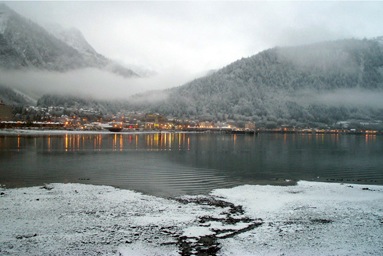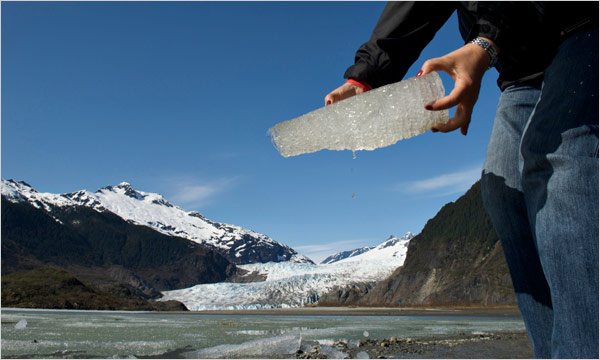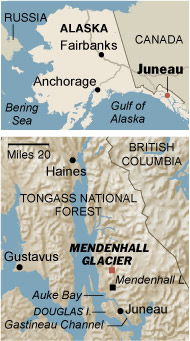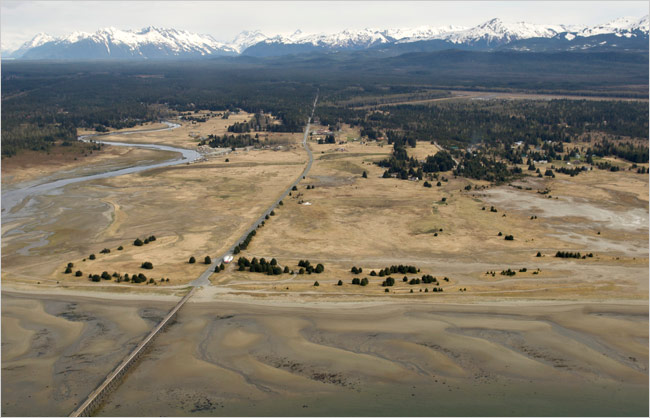| Il paraît que ça
frite dur dans la région de Juneau, au sud-est de l'Alaska. Car
depuis une cinquantaine d'années, le niveau de la mer baisse, libérant
de nouvelles terres que les riverains se disputent. Paradoxalement, ce
recul de l'océan serait lié au réchauffement climatique.
Car les glaciers morflent particulièrement dans la région.
Et au fur et a mesure qu'ils disparaissent, l'écorce terrestre,
privée de leur poids, redresse la tête (1). Et, comme
dans d'autres régions du monde (notamment au Groenland et en Scandinavie),
les terres émergées remontent plus vite que le niveau des
océans... Serait-ce la raison des prises de position de Sarah Palin,
ex-candidate à la vice-présidente, sur la négation
du récuaffement climatique.
Dans la région de Juneau (la capitale de l'état d'Alaska), raconte un journaliste du New York Times, il y a intérêt à disposer de tables de marées à la page. Car sur certains rivages, le retrait de l'océan est très rapide: plus de trois centimètres de hauteur d'eau par an! A Juneau, la baisse du niveau de l'eau atteint 3 mètres depuis 1750... Par endroits, elle serait du double! Et les géophysiciens prédisent encore un bon mètre de plus d'ici la fin du siècle (2). Un phénomène renforcé par le ballet des plaques tectoniques. D'ailleurs, ces modifications de l'écorce sont un vrai viagra pour failles géologiques, et les séismes devraient se multiplier. Conséquence de tout cela, la géographie est profondément modifiée. Car si les roches s'élèvent, les eaux souterraines restent à leur niveau. Ce qui revient à dire qu'elles sont plus profondes. Résultat: des cours d'eau se tarissent, notamment des rivières à saumon. Des zones humides disparaissent, et les bestioles qui y vivaient sont en galère. Et les gros navires commencent à ramer le long de certains rivages. 
Près de Juneau © Devita Writer / Alaska Division of Community and Business Development Evidemment, ça fait aussi des heureux, raconte le NYT. Il cite un propriétaire qui a pu installer un golf de 9 trous sur des terres qui étaient immergées à l'époque de son père. Et qui se prépare à en créer un second... Reste aux autorités à régler une épineuse question: à qui attribuer chaque nouvel hectare de terre qui sort de l'océan? Sarah Palin a du pain sur la planche... (1) En jargon scientifique, on parle de rebond isostatique. (2) Lire le rapport consacré en 2007 à cette région. By CORNELIA DEAN
JUNEAU, Alaska — Global warming conjures images of rising seas that threaten coastal areas. But in Juneau, as almost nowhere else in the world, climate change is having the opposite effect: As the glaciers here melt, the land is rising, causing the sea to retreat. 
Now, with the high-tide line receding even farther, he is contemplating adding another nine holes. "It just keeps rising," he said. (suite)
|
suite:
The geology is complex, but it boils down to this: Relieved of billions of tons of glacial weight, the land has risen much as a cushion regains its shape after someone gets up from a couch. The land is ascending so fast that the rising seas — a ubiquitous byproduct of global warming — cannot keep pace. As a result, the relative sea level is falling, at a rate "among the highest ever recorded," according to a 2007 report by a panel of experts convened by Mayor Bruce Botelho of Juneau. Greenland and a few other places have experienced similar effects from widespread glacial melting that began more than 200 years ago, geologists say. But, they say, the effects are more noticeable in and near Juneau, where most glaciers are retreating 30 feet a year or more. As a result, the region faces unusual environmental challenges. As the sea level falls relative to the land, water tables fall, too, and streams and wetlands dry out. Land is emerging from the water to replace the lost wetlands, shifting property boundaries and causing people to argue about who owns the acreage and how it should be used. And meltwater carries the sediment scoured long ago by the glaciers to the coast, where it clouds the water and silts up once-navigable channels. A few decades ago, large boats could sail regularly along Gastineau Channel between Downtown Juneau and Douglas Island, to Auke Bay, a port about 10 miles to the northwest. Today, much of the channel is exposed mudflat at low tide. "There is so much sediment coming in from the Mendenhall Glacier and the rivers — it has basically silted in," said Bruce Molnia, a geologist at the United States Geological Survey who studies Alaskan glaciers. Already, people can wade across the channel at low tide — or race across it, as they do in the Mendenhall Mud Run. At low tide, the navigation buoys rest on mud. Eventually, as the land rises and the channel silts up, Douglas Island will be linked to the mainland by dry land, said Eran Hood, a hydrologist at the University of Alaska Southeast and an author of the 2007 report, "Climate Change: Predicted Impacts on Juneau." When that happens, Dr. Hood said, the Mendenhall Wetlands State Game Refuge, 4,000 acres of boggy habitat, will be lost. "That wetland will have nowhere else to go," he said. In some places along the coast, the change has been so rapid that kayakers whose charts are not up-to-the-minute can find themselves carrying their boats over shoals that are now so high and dry they now support grass or even small trees. In and around Juneau, "you can walk around and see what was underwater is turning into grassland and eventually into forest," Dr. Hood said. The topographical changes have threatened crucial ecosystems and even locally vital species like salmon. "The lifeblood of our region has been salmon species and their return — and what is the impact when they return and the streams are dry?" said Mayor Botelho, who was born and raised in Juneau. "The salmon is bound to our identity as a region, who we are." He said he did not think that any species were in imminent danger, but added, "Anyone who is following climate change has to see that there are risks, perhaps great ones." Dr. Hood said many people in Juneau had hoped to maintain a waterway called Duck Creek as a salmon stream. But small streams like that "appear to be drying out," he said. "There are a lot of people in town saying, Let's just let it return to a greenway." Relative to the sea, land here has risen as much as 10 feet in little more than 200 years, according to the 2007 report. As global warming accelerates, the land will continue to rise, perhaps three more feet by 2100, scientists say. The rise is further fueled by the movement of the tectonic plates that form the earth's crust. As the Pacific plate pushes under the North American plate, Juneau and its hilly Tongass National Forest environs rise still more. "When you combine tectonics and glacial readjustment, you get rates that are incomprehensible," Dr. Molnia said. In Gustavus, where Mr. DeBoer's property is, the land is rising almost three inches a year, Dr. Molnia said, making it "the fastest-rising place in North America." In addition to expanding the golf course, Mr. DeBoer is negotiating with the Nature Conservancy to preserve some of the newly emergent land. He can do both, he said, because the high tide line has pushed almost a mile out to sea since his family first homesteaded on the property. Where the shoreline is relatively flat, "it doesn't take much uplift to make quite a bit of difference," Mr. DeBoer said. Kristin White, a 28-year-old schoolteacher who grew up in Haines, a town north of here, is from another family in the area whose real estate grew as land rose. When her father tried to sell some property in Haines, she said, "he had to have it resurveyed." But for Ms. White, who has vivid memories of visiting the Mendenhall glacier as a child, the gain in acreage has been bittersweet. Seeing the glacier retreat, she said, is "as if you lived in the Smoky Mountains and you were used to seeing certain peaks — and they disappeared. It's just totally, totally sad." |

